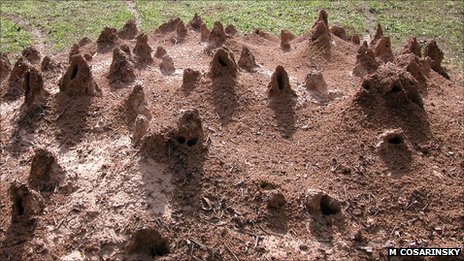Humans have been believed to be the pioneers of revolutionary architecture and ergonomic design. However, humans are not the only ones, even animals have successfully built intricate homes and structure. The animal kingdom is not short of builders, engineers and architects. Following are animals and insects that are known for their architectural skills.
The Animal Engineers:
1. Ant turrets/ Ant hills

When one looks at ant hills, they appear as simple mounds or hill-like structures. However, ant turrets are extremely complex structures; almost like a city built on and under the earth. The complexity of the ant hills was understood when entomologist poured cement into these structures. These structures were able to hold approximately 10 tonnes of cement water. On digging, it was found that ants build nests that can house up to 7 million insects. It is not the enormity of the ant hills is what makes ants good engineers, but the fact that the walls of these structures are highly porous, that enables carbon dioxide to escape and make room for fresh oxygen.
In experiments, ants have been provided with different materials to build and depending on the material, they change the way they build their ventilation systems. This and other experiments prove that ants are able to sense minute differences in the density of the soil. Ants also prepare a fungal garden for the purpose of ventilation and moreover to feed their young ones. The mounds they build are commonly 6-8m in diameter, almost 1m high and weigh approximately 40 tonnes
Source
2. Beavers

Beavers are one of the very well-known architects in the Animal Kingdom. This is because they build structures that are similar to dams, and successfully obstruct water flows. These nests, not only provide them with safety from predators but also function as a storehouse for food during winters. These nests are built with twigs and tree branches. Beavers are known as lumberjacks of the forest, they cut trees to use them to build dams. Since these nests house a huge family of beavers, they are engineered with a good ventilation system. In addition to this, they have two entrances to their nest. One of them situated underwater, since snow covers the nest in winters.
3. Compass Termites

Amitermes meridionalis, commonly known as the magnetic termites or Compass termites build tall wedge-shaped wall like mounds. From a distance, these structures look like tomb stones and can be as high as 13 feet and 3 feet deep, with a width of 2meters. The outer covering is more strong and durable as opposed to the inside, which is more paper like.
Native to the Northern Territory of Australia, the most striking features of these structures is their north- south orientation. Like any other nest, or house, ventilation is of key importance. The north south orientation is precisely for ventilation and temperature regulation, since the mounds house upto million individual termites, which are usually categorized as the king, queen, reproductive, soldiers and workers. The structures receive the warmth of the sun on their eastern and western sides in the morning and evening while exposing less surface to the sun at midday when the nest might overheat. The interior of the mound is kept at a relatively stable temperature and a high humidity. In the monsoon they stay in and feed on the grass, hay and vegetation that they have stored in the mound chambers.
Source
These nests and structures, provide us with a deeper insight into the behaviour and functioning of insects and animals. The question that one could now ask is, if humans could benefit from the knowledge of these architectural structures.
Also, read about Ancient Unexplainable Inventions
Subscribe to Engage Learning and improve the way your child learns
